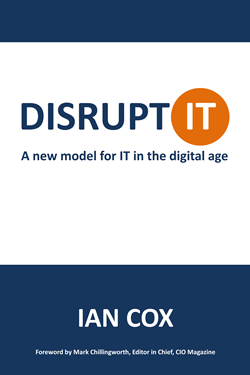Guest blog by Ian Cox, excerpted from his new book, Disrupt IT.
 Faced with the disruption of their roles, the CIO and the IT function need to change. To survive the perfect storm of disruptive technologies and trends, tech-savvy colleagues, higher expectations, vendors going directly to other executives, business units bypassing the IT function and shadow IT, CIOs need a new model for IT in the digital age. But this new model is more than just another step in the evolution of the IT function; to close the gap between the capability of IT and the expectations of the rest of the business, this change has to be equally, if not more, disruptive in order to create a sustainable and long-term model for IT.
Faced with the disruption of their roles, the CIO and the IT function need to change. To survive the perfect storm of disruptive technologies and trends, tech-savvy colleagues, higher expectations, vendors going directly to other executives, business units bypassing the IT function and shadow IT, CIOs need a new model for IT in the digital age. But this new model is more than just another step in the evolution of the IT function; to close the gap between the capability of IT and the expectations of the rest of the business, this change has to be equally, if not more, disruptive in order to create a sustainable and long-term model for IT.
CIOs need to think disruptively
 Disruptive thinking involves challenging constraints, questioning even the most basic and long-standing of assumptions to create different thought patterns and a new model for IT in the digital age.
Disruptive thinking involves challenging constraints, questioning even the most basic and long-standing of assumptions to create different thought patterns and a new model for IT in the digital age.
True disruption comes from redefining business models, not business processes. In other words, it is about starting again without being limited by what has gone before, old ways of working and thinking, and legacy solutions and technology. That is one of the advantages companies, and particularly start-ups, have when entering a new market; they do not have the constraints of legacy systems and processes, and ingrained thinking. New entrants can look at markets afresh, identify customer needs and then take advantage of new technology, ideas and thinking to design business models that offer products and services that better meet those needs.
A new business model for IT
So how does the CIO disrupt IT? How do they design a new model for the IT function that is not constrained by what IT departments look like today? How do they make a truly disruptive change to the IT business model that forces it from the Service Provider era in which it has become stuck into a model that is fit for the digital age?
What would a new player in the IT market do? Would they start by buying, building and configuring servers, buying and installing software, establishing service desk and support teams, etc.? Certainly not. In fact, given the way technology and its use within business has changed in the mobile computing era, it is unlikely that someone creating an IT department from scratch for a business in the digital world would ever do those things.
To create disruption in IT a new entrant would start by identifying what the rest of the business needs from its IT department. It would then design a new business model for IT that met those needs in the most efficient and cost-effective way using the latest technology and vendor offerings, combined with new thinking and lessons from other industries.
With the gap between the capability of the IT function and the expectations of the rest of the business now so wide, the result of this process would inevitably be a very different looking type of IT function compared to the service provider model that exists today. This new model is also likely to have a more focused role and a clear understanding of how and where it adds value to the organisation.
An IT function for the digital business
The range and type of technology products and services has grown significantly over recent years and so has the number of technology vendors. As a result it is now possible for an organisation to source most, if not all, of its technology needs from external service providers. Indeed, this is how most start-ups operate; cloud-based systems are used for everything from finance and HR through to customer relationship management, collaboration tools and content management systems.
And every day, new and improved devices, applications and services are launched into an already crowded and complex market place. And they are being marketed directly to non-IT functions. So when asked what they need from IT, the rest of the business says that they need their IT department to work with them to decide which products and services are relevant to their needs and to advise how they can be deployed alongside other tools. But they do not expect IT to be the provider of those products and services or to be involved in supporting or administrating them on an ongoing basis.
The IT department needs to be a partner to the business in the selection process, not the gatekeeper it has been in the past. The days of the CIO alone making decisions about which technologies, tools and systems are allowed into the organisation are over. Decisions about technology need to be made jointly between IT and the relevant stakeholders.
The business needs IT to act as its broker for technology and services, knowing what is out there, how (and whether) it works, assessing vendors, validating security and understanding service levels. And once a decision to purchase has been made and the solution deployed, the business needs its IT function to manage the technology and service providers on its behalf. The IT function needs to ensure solutions continue to be secure, that service levels are met and integration points with other solutions are maintained. But the rest of the business also needs IT to step back on a day-to-day basis, leaving the other functions free to use the tools, systems and data as they require and without the involvement of the IT department.
Technology is fundamental to the digital business. It is being used to create new business models, products and services. As the organisation’s technology partner and broker, the IT function needs to play an integral part in the design and transformation of new business models and in creating new and enhanced products and services. The CIO and IT staff need to be capable of engaging in the full business lifecycle, contributing to the discussion and using their knowledge of both the business and technology to help shape business outcomes, create value and increase revenue.
The new era for IT has started, but CIOs and IT departments are behind the curve and are in danger of being bypassed as a result. CIOs still have time to transform their departments and their own roles but they need to act now. They have to disrupt IT to break out of the service provider model and create the type of IT function needed by a digital business: the technology and service broker.

Written by Martha Heller
Martha Heller is CEO of Heller and author of Be the Business: CIOs in the New Era of IT, and The CIO Paradox: Battling the Contradictions of IT Leadership.


